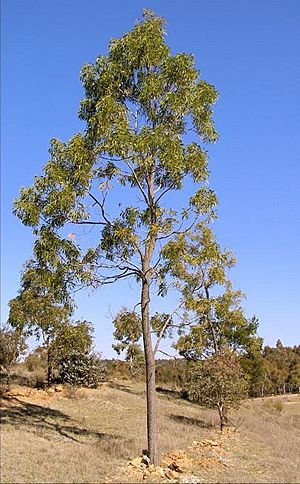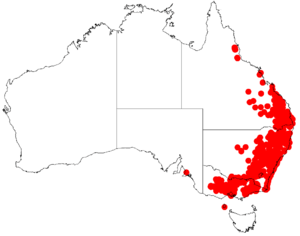Lightwood facts for kids
Quick facts for kids Lightwood |
|
|---|---|
 |
|
| Acacia implexa | |
| Scientific classification | |
| Genus: |
Acacia
|
| Species: |
implexa
|
 |
|
| Occurrence data from AVH | |
Acacia implexa, commonly known as lightwood or hickory wattle, is a fast-growing tree found in Australia. Its strong wood is highly valued for making furniture because of its beautiful finish. In the past, people also used the tree's leaves to make paper pulp and to dye cloth.
Contents
About the Lightwood Tree
This tree is known for living a long time. It usually grows to be about 5 to 15 meters (16 to 49 feet) tall and 4 to 10 meters (13 to 33 feet) wide. It can have one main trunk or several. The bark is rough and greyish.
Leaves and Flowers
The Lightwood tree has light green, curved leaves called phyllodes. These can be up to 20 centimeters (8 inches) long and 6 to 25 millimeters (0.2 to 1 inch) wide. They have several clear veins and many smaller ones running through them. Sometimes, younger leaves might even have a purple color.
In summer, the tree blooms with round, cream-colored flowers that smell very nice. Each flower head is about 5 to 6 millimeters (0.2 inches) across and holds 30 to 52 small flowers.
Seed Pods
After the flowers, the tree grows thick, woody seed pods. These pods are long and can be twisted or coiled, reaching up to 25 centimeters (10 inches) in length. Be careful, as dust from these pods can irritate your eyes and nose!
The wood of the Lightwood tree is very similar to another Australian tree, Acacia melanoxylon, and they are often confused.
Where Lightwood Grows
The Lightwood tree is found across eastern Australia. You can see it from the central coast of Queensland down to southern Victoria. It also grows in places like the Atherton Tableland in northern Queensland and Tasmania's King Island.
This tree often grows on fertile plains and in hilly areas. It prefers open forests and can be found in shallow, drier sandy and clay soils.
Traditional Uses by Aboriginal People
The Ngunnawal people, who are the traditional owners of the land in the ACT region, used the Lightwood tree in many ways. They used the bark to make rope and string. It was also used for medicine and to help catch fish. The timber was useful for making tools, and the seeds were ground into flour.
Growing Lightwood Trees
The Lightwood tree is very tough and easy to grow. It's great for helping to stabilize soil, especially on banks, because its roots can spread out. If the roots get damaged, it can even grow new shoots quickly.
This tree loves full sun and can handle both drought and frost. It can survive temperatures as low as -7 degrees Celsius (19 degrees Fahrenheit). However, it can sometimes get a leaf gall, which is a type of swelling on the leaves.
Images for kids







